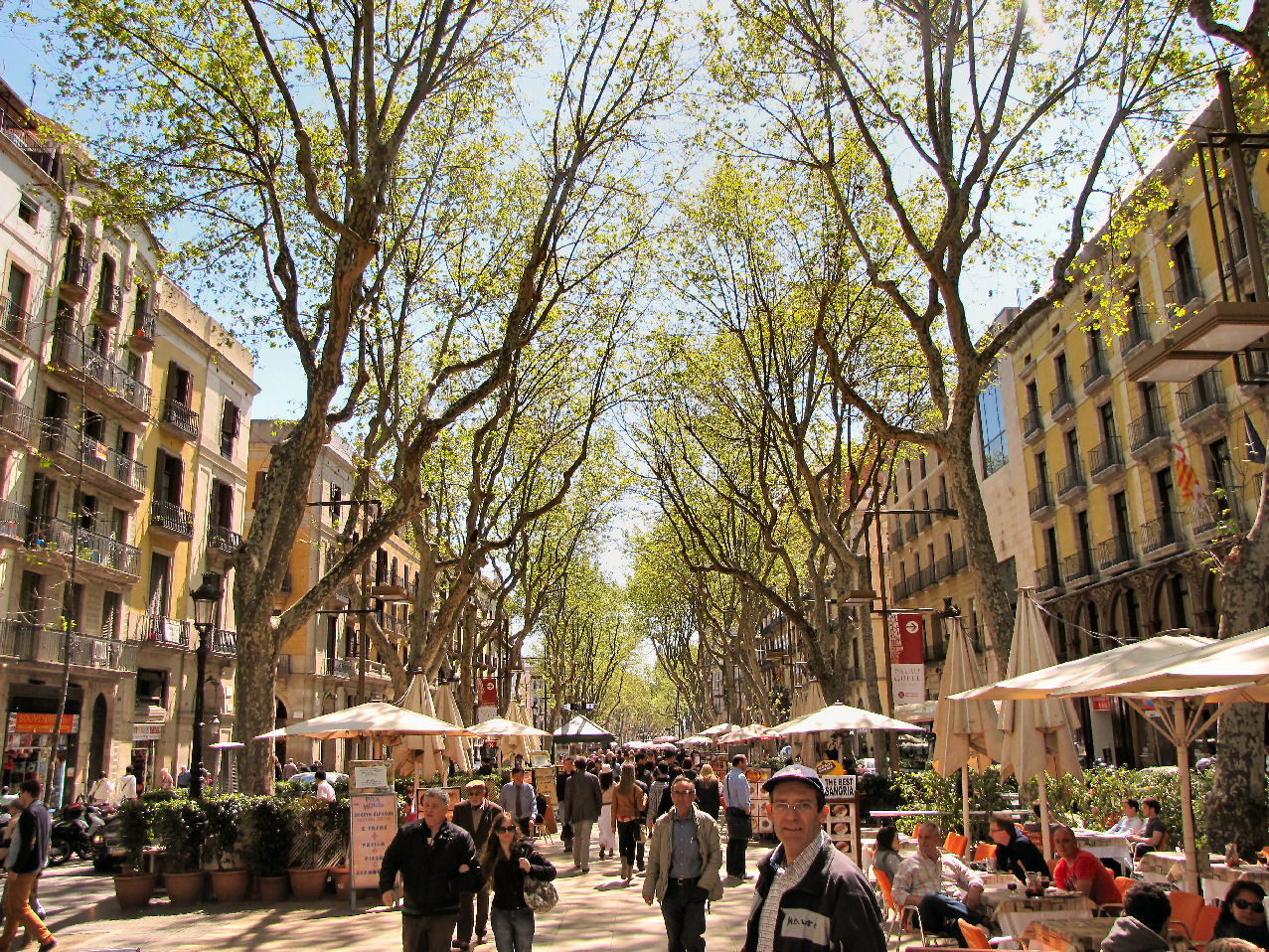Las Ramblas, the central promenade
We´ll stay on the topic of Barcelona, and I´ll walk you through the interesting stories and facts about the city´s most popular tourist spots.
Today I´ll be telling you about Las Ramblas. There are numerous interesting places and important cultural attractions in Barcelona, plus many famous spectacles and settings... but the first one a Barcelona native will name you is Las Ramblas. It´s possible that before even knowing about the existence of the Sagrada Familia (the majestic and still incomplete Catalonian cathedral designed by Antoni Gaudí), or Park Güell (the spectacular park featuring the most popular views over the city), people automatically associate Barcelona with Las Ramblas, even before knowing what this name refers to.
Las Ramblas
´La Rambla` or ´Las Ramblas` (the plural form is generally the most common) is the name which refers to this seemingly unending promenade situated in the very city centre where visitors enjoy a recreational area focused on leisure and rejuvenation, between Plaça de Catalunya and Port Vell, the old port. The promenade runs through the city centre, and is always crammed with tourists, regardless of the time of year or the time of day. Shops, restaurants, stalls and kiosks, street performers and vendors fill the kilometre-odd stretch day and night. A mix of worldwide cultures can be enjoyed here, since Las Ramblas is usually top of every tourist´s list of must-sees. This is probably also the reason why the area has such a high number of pickpockets. It´s not unusual to see policemen strolling down Las Ramblas, as theft incidents are very high: for this reason it´s very important to look after your belongings well, especially when it´s obvious you´re a tourist - socks and flip-flops plus a camera hanging round your neck are clear giveaways!
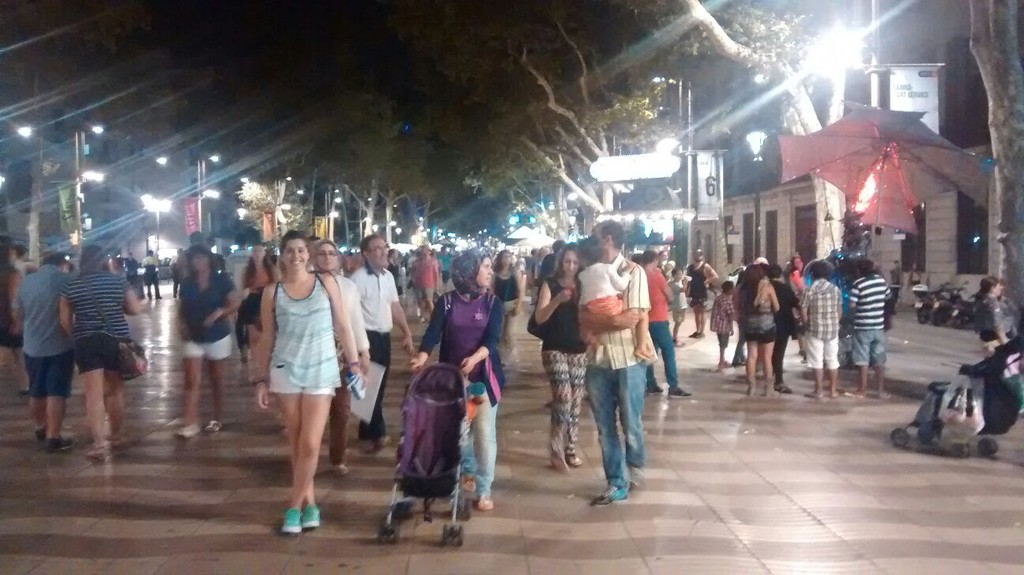
What´s in a name?
The name ´Las Ramblas` refers to a sandy area, and comes from the Arabic ´ramla´.
Around every 200 metres along the kilometre-long promenade, La Rambla is divided into different stretches with names corresponding to the places of interest situated in these zones:
- Rambla de Santa Mónica: name of the most southern stretch which ends in the Columbus Monument at the entrance to the old port.
- Rambla del Centro o de los Capuchino: this stretch continues on from the Rambla de Santa Mónica.
- Rambla de las Flores: trees line either side of the entire promenade, adding a welcoming atmosphere and a touch of vegetation to this city-centric street. On this stretch of Las Ramblas, the street is more coloured than usual since among the normal shops, kiosks and small flower stalls spring up, sometimes offshoots of businesses located elsewhere in Barcelona.
- Rambla de los Estudios: this stretch was once the location of the university, hence its present name. A bird market also used to be here, and therefore some locals still refer to it as the La Rambla de los Pájaros.
- Rambla de Canaletas: the name of this stretch refers to the Fuente de Canaletas nearby, the place where all the supporters of Barcelona football club gather together to celebrate their team´s victories.
Fuente de Canaletas (Canaletas Fountain)
The Fuente de Canaletas (or Font de Canaletes in Catalan) was built in 1863 in preparation for the International Exposition of Barcelona in 1888 (an event we have referred to already in previous posts, it being clear that the Exposition lead the Catalan city to reform itself and build many new monuments which made it into a more modern and suitable city for this event). In reality, for those who have never seen it before but know of it as the meeting point of the ´culés`, the Fuente is slightly disappointing since it is much smaller than may have been expected: made of iron with four pumps, a relief of the city´s coat of arms can be seen along with lanterns which illuminate the fountain.
The tradition of celebrating next to the Fuente de Canaletas, and not in a place closer to Camp Nou as would perhaps be expected, goes back to the 1930s, where the sports correspondents of ´La Rambla` newspaper would congregate at this spot to report on football games, erecting a large board of scores next to the fountain. Fans would come to find out how their team had faired that day.
There is also a legend surrounding the fountain which tells us that every person who drinks from it will return to Barcelona. On a plaque nearby are written the words: ´Si beveu aigua de la Font de Canaletes sempre més sereu uns enamorats de Barcelona i per llunt que us nàneu tornareu sempre`. (If you drink water from the Font de Canaletes, you will always be a lover of Barcelona, and no matter how far you stray, you will always return here. )
In ancient times, the Roman city on this spot was named Barcino, which has developed into the modern-day term Barcelona. There was an extensive water channeling system throughout the city, which transported water from the Besós and Collserola rivers - just one of the Romans´s engineering ideas which has always amazed us. Today, almost none of the aqueducts have been conserved - due to the continual development and growth of the city, they have been used as supporting structures for the construction of the shops along the street. These canals had been functioning since the tenth century, but with the passage of time, industrialization and the decline of the primary sector, they became contaminated and in turn contaminated the water flowing through them. The system was expanded in the nineteenth century in order to allow less contaminated water to flow to Las Ramblas for the purpose of watering farmers´s fields and filling water troughs for horses. These diverted offshoots of the canal were christened ´canaletas` (little canals), from whence came the name of the fountain.
A trip to Las Ramblas is imperative for every visitor to the city, since in addition to enjoying the street´s atmosphere, numerous important buildings can be found on either side of the street, such as the Teatro de Liceo (in the middle of the promenade), the Palacio de la Virreina, and the famous La Boquería market.
Now for a whistle-stop tour of all the touristic places of interest surrounding Las Ramblas which can be visited.
1. Plaça de Catalunya
The square par excellence of the Catalan city, 30, 000 metres approximately in size, where you´ll find the large department stores such as El Corte Inglés and the Barcelona Football Club shop, important restaurants like the Hard Rock Café, bus stops for the city tour buses or for buses to the airport, as well as information kiosks or the ´underground` tourist information office - an important detail, since although we saw the large ´i` information signs, we couldn´t actually find the tourist information office. It turned out that it´s located underneath the square, down some stairs on either side, where you find a large hall full of people, with screens and leaflets everywhere which will answer all of your questions.
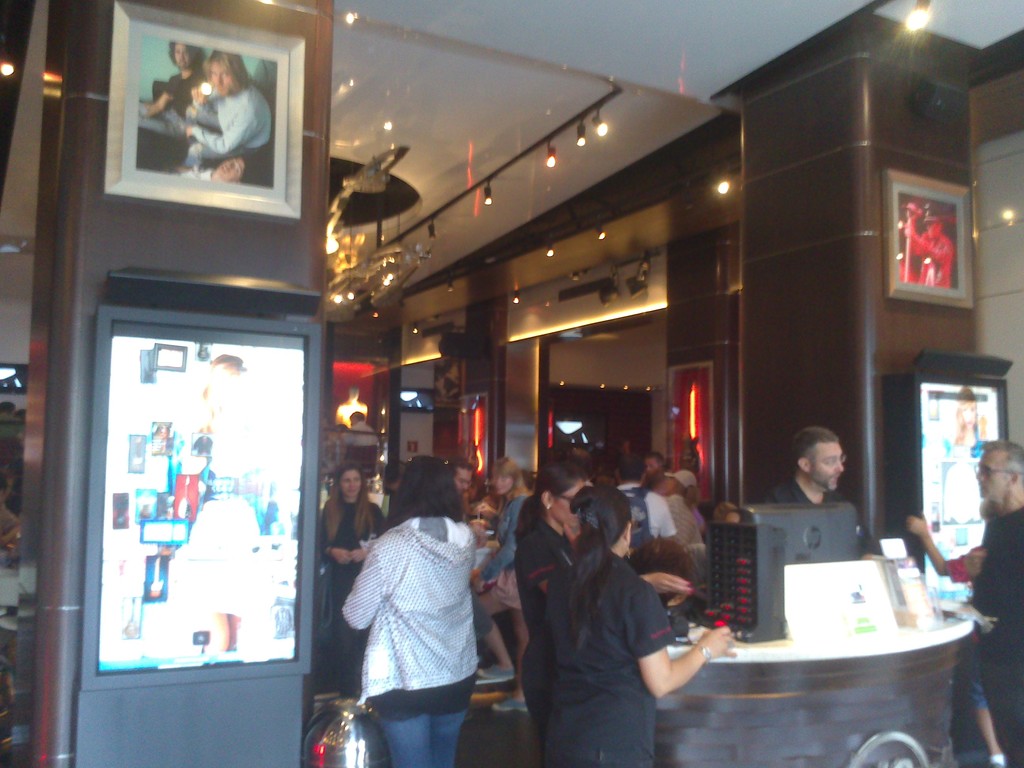

Here are some photos for you of our meal in the Hard Rock Café. The same as everywhere else in the world, but so delicious that it´s worth stopping and making an exception. The only problem: the long wait!
This large square marks the very centre of Barcelona. It´s full of people 24/7, be they tourists or locals. It´s the meeting point for every city tour or event celebration, as well as being perfectly located for getting to any part of the city.
2. La Boquería market
This market is actually called San José, but is commonly known as ´La Boquería`. Previously the location of the Convent of San José, which burned down in a fire, the decision was made to maintain the structure it has today and the market was moved to the location.
La Boquería is the Barcelonian equivalent of a selective market or a ´gourmet` (very fashionable today), where the products sold are fresh and of good quality, ranging from beef and cold cuts to fruits and pastries. Here you can find all kinds of food, including exclusive items which you can´t find in other places. Unfortunately (although not so much for me), this market has become so popular with tourists that you end up having to walk the entire 2, 500m2 to find the product you´re looking for among the more than three hundred stalls. It´s pleasant to make a quick stop, take a look and buy one of the fruit salads, fruit milkshakes, or one of the set menus. Although the prices are a bit high, it´s worth trying something from La Boquería, since the quality is obvious.
The market seems to be closed on Sundays, so if you want to visit, you can do so on any other day between the hours of 8am and 8. 30pm.
For more information, take a look at La Boquería´s webpage: http://www.boqueria.info/index.php?lang=es
3. Teatro el Liceo
This theatre, dating from 1847, is of great importance to the city of Bareclona, and its importance has only grown through the numerous accidents it has suffered over time. At the foot of Las Ramblas, its facade is attention-grabbing due to its style being so dissimilar to that of the buildings surrounding it. Hosting performances for more than 150 years, it is the oldest theatre in Barcelona.
Since its construction in 1847, the Teatro de Liseo has suffered a fire in 1861, an anarchist attack in 1893 and another more recent fire in 1994. Despite all this, the theatre has been continually reconstructed in its original style, and decorated as true to the original as possible.
It´s not possible to visit the theatre without attending a show. However, guided tours are permitted entry, although unfortunately (due to lack of time, money and other things we wanted to see), we didn´t have the opportunity to see the theatre from inside. We learned about the theatre from a guide (whose company I´ll mention later), who lead us on a tour down Las Rablas, through the Raval and Gothic neighbourhoods, telling us many interesting facts, including some on this theatre. The tour lasted twenty minutes (quite a quick tour) for 5. 30 euros, or 11. 25 euros for a tour lasting about an hour. The tours only run in the mornings, with the first one-hour tour beginning at 10am, the rest beginning at 11am and running every thirty minutes until 1pm.
Here is the theatre´s webpage, should you want to take a look at the events and reserve tickets in advance, or just to have a point of contact:
http://www.liceubarcelona.cat/
4. Wax Museum
Barcelona, of course, also has a wax museum. This can be found almost at the end of the promenade next to the port, descending Las Ramblas and turning left down to the bottom of an alleyway. Don´t worry though if you can´t find it: the advertisements makes sure that you don´t miss it, with large banners and a small ticket booth.
Look for the building with the large entrance at the end of the alleyway. On the right hand side, there´s a café called ´El bosque de hadas` (The Fairy Wood). It´s a very strange-looking place, since it looks like it has trees growing inside it and they even have what looks like little animals hanging from the ceiling so that it really looks like a forest. We weren´t exactly sure what it was, but we went in anyway. Inside, there´s a little shop which sells crafts and opposite some tables among the trees for sitting and having a drink. It´s a pretty place for what it is, because it´s different and original, and because of the atmosphere it evokes... but I have to say it´s really dark in there, and they have ambiental music playing too loudly. So it´s not really the ideal place to have an afternoon coffee.
Returning to the Wax Museum, we visited it at 7pm, almost the latest admission time. Entry is free, and you can take as much time you want in every room. The direction of the tour is clearly signposted, so it´s impossible to get lost. After climbing some stairs, you can access the whole interior of the museum, with rooms dedicated to historical or fictitious people, some of which were brilliantly imitated: from Juan Carlos I, the King of Spain and his wife Doña Sofia, to the feared murderer Freddy Krueger, as if we had stepped back in time. I have to admit there were a lot of occasions on which we didn´t know who the models were, but it was still interesting (and was also the first wax museum I´ve ever visited, so perhaps it impressed me more because of this).
A horror exhibition has been on show at the museum since April 2014: ´The Wax Museum Horror Experience´. I have to say though that we didn´t visit it. We asked in reception if it was suitable for ´scaredy-cats` and they said it was best not to go in. So, I can´t recommend the exhibition because I didn´t trust myself to go in, and I don´t know exactly what it´s like.
If you want to visit the Wax Museum, check the opening hours since it closes at midday and therefore closes relatively early later on. During the week, it´s open from 10am to 1pm and then 4pm to 7. 30pm. On public holidays and festival days the hours are more or less the same, but then the museum usually closes an hour earlier. I think I read that the visiting hours are longer in the summertime (July and August), but I´m not 100% sure about this. Visit their website for more information. You can also find information about the café in ´El Bosque de las Hadas` on this site.
http://www.museocerabcn.com/es/
5. Christopher Columbus Monument
At the end of the promenade is a monument dedicated to the celebrated Christopher Columbus. His statue sits atop a 60 metre high column. The construction of the monument dates back to 1888, also completed for the purpose of the International Exposition which took place in the same year. Unfortunately, we didn´t get to visit to appreciate the view from the top - however, the people we met didn´t particularly recommend we visit the monument. The Barcelona locals we met told us that the view from Montjuic mountain was much more impressive, since the observatory at the top of the monument is very small and you end up being crushed against other visitors, which doesn´t make for a pleasant visit. If you still want to visit however (which I of course still encourage you to do! ), the price is only 4 euros per person and the opening hours are from 8am to 8pm daily.
6. Port Vell (Old Port)
The port of Barcelona is situated at the very end of Las Ramblas. In addition to being a dock for sports boats and cruise ships, it also features the Maremagnum, a shopping centre and a recreational and leisure area open to anyone who wishes to visit. Like every shopping centre, it features shops and restaurants to pass your time in, but undoubtedly the best thing to do is to wander through and eat an ice cream or drink a coffee with views of the sea. You often come across street vendors selling bags, scarves and caps, and street artists too. We came across two guys dancing a type of breakdance in the lower part of the port and (since I love all kinds of dancing and couldn´t have done otherwise! ) I insisted that my friend and I stay and stand in the group congregated next to the railing to watch the dancers. I think if you´ve got time it´s a place definitely worth visiting by day and by night, taking the time to appreciate the views and the walk along the seafront, and not just the Maremagnum.
Continuing on along Las Ramblas...
Las Ramblas are, of course, a very emblematic place in Barcelona, however your visit to Barcelona shouldn´t stop here. To discover some other areas of the city, we orientated ourselves from Plaça de Catalunya. From here, you can see almost all of the ´Ciutat Vella` (Old Town): on the right, you can find the Raval area, and on the left, the ´Barri Gotic` (Gothic neighbourhood).
We stayed in the Raval area, in a friend´s house who gave us the room to stay in for a few days. If I´m honest, it was great to find that the flat was so centrally located, since as well as having a good atmosphere, the transport connections couldn´t have been better. There are lots of hotels in the area and lots of lovely terraces: bars with wooden decoration, restaurants with carvings on the tables... a really lovely area.
On the other hand, we visited the Barri Gotic on a guided tour, which thanks to our informative guide allowed us to delve deeper into the history and charm of this old neighbourhood: we learned which of the arches were actually old entrances in the former city wall, discovered beautiful squares in the most hidden places, and learned how the smallest streets have entrance and exit signs which mark where the merchant carts should go, making the alleyways one-way streets due to their narrowness.
Guided Tours
In many of the most important European cities, there are lots of companies (there used to be less, but due to mass popularity their number has significantly increased) which offer free guided tours of particular areas in a range of languages. These guides meet their group in a set spot, give the tour and then ask for a ´donation´, which everyone of course gladly gives. Each person usually donates between 5 and 10 euros, as far as my experience goes.
To join a tour, you should visit the website and consult the days and times available, which language you would like and above all, the availability. Sometimes places are limited, and other times there is no limit.
This is the website we used to find tours in Barcelona. If you type ´free walking tour´ and the city name into Google, you´ll be able to browse through all the possibilities.
How to get to Las Ramblas
As I´ve already mentioned, Las Ramblas is a long promenade packed full of tourists, and where the transport and traffic is very limited. On both sides of the promenade there are asphalt paths, which count as roads for traffic in one direction only, although it´s not hard to mistake them for pedestrian areas since people often walk on them.
Using the metro
There are several metro stops along the promenade which will drop you closer to the area you want to visit. The green line (Línea 3) is the one which covers all the stops on Las Ramblas: Calaluña in the north (shared with the red line, Línea 1), Liceu (next to the theatre) and Drassanes (next to the Christopher Columbus monument).
Speaking of the Teatro el Liceo, when you visit, you should take a look at the ground outside. Along the pavement of Las Ramblas, two spiralling grey lines can be seen. In contrast, a circular colourful mosaic can be seen by the theatre, created by no less than the artist Joan Miró.
Eating out on Las Ramblas
Well... I actually wouldn´t recommend doing this, despite the amount of people who do it. All along the promenade there are numerous restaurants and terraces - however, the quality is much worse than expected, and the price has a nasty effect on a tight purse! I presume these places charge such high prices because of the huge amount of tourists: there will always be someone who wants to take a rest from walking. We also stopped because we were tired and thought it would be a good idea to sit there (expecting it to be expensive, but not too expensive). We had a few glasses of sangría, and it was a rip-off: each glass, bearing in mind that half of the glass was full of ice, cost 8 euros. What a profit they must be making! Generally it´s a better idea to make a pit-stop in a less touristy area and enjoy taking a break more peacefully, definitely more cheaply and with better food and service. However, this is just my personal opinion!
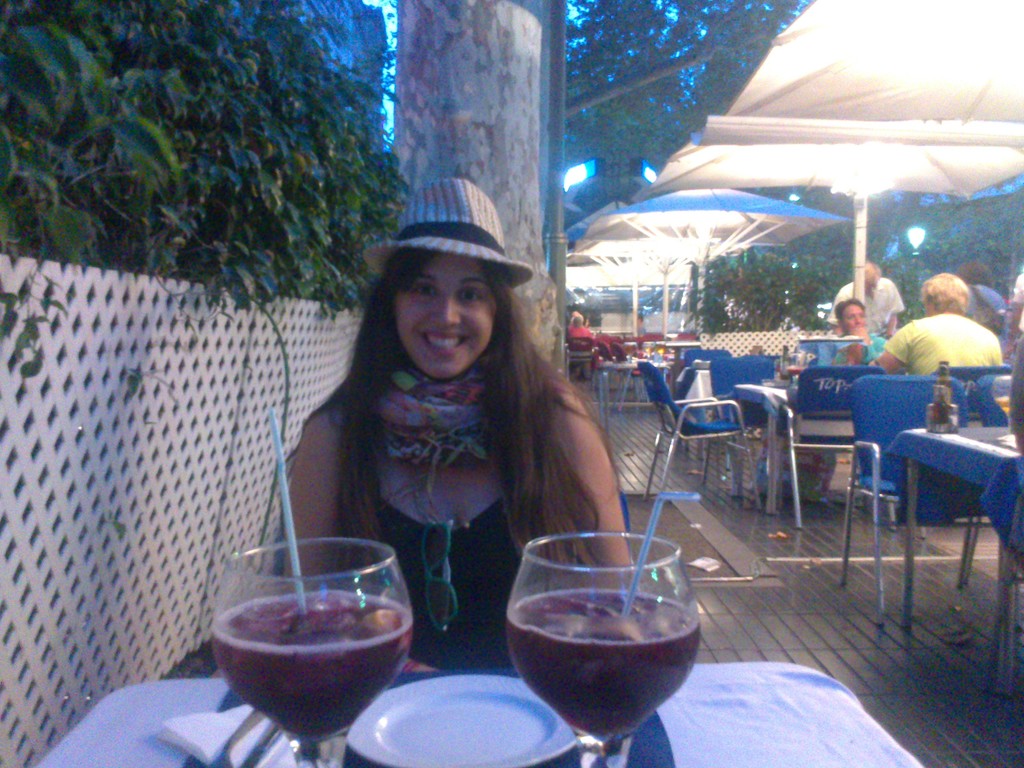
Sorry that I haven´t added more photos, but it wasn´t a trip where we took lots of photos - we have a lot of memories instead. :) For more photos, take a look at the links I´ve given you... however, I hope the information about the good and bad parts of our trip have been interesting to you and were helpful!
Until next time!
Photo gallery
Content available in other languages
- Español: Las Ramblas, un céntrico paseo
- Italiano: La Rambla, una passeggiata in centro
Best walking
La Rambla is probably the most famous street in Barcelona. It is located in the Barrio Gótico, an historic neighborhood in the city. It starts in Catalunya square and it ends at Port Vell harbour.

Walking through the street (which is almost all for pedestrians) you will find many beautiful buildings from the 19th century, and also many typical spanish restaurants to eat some tapas and paella.
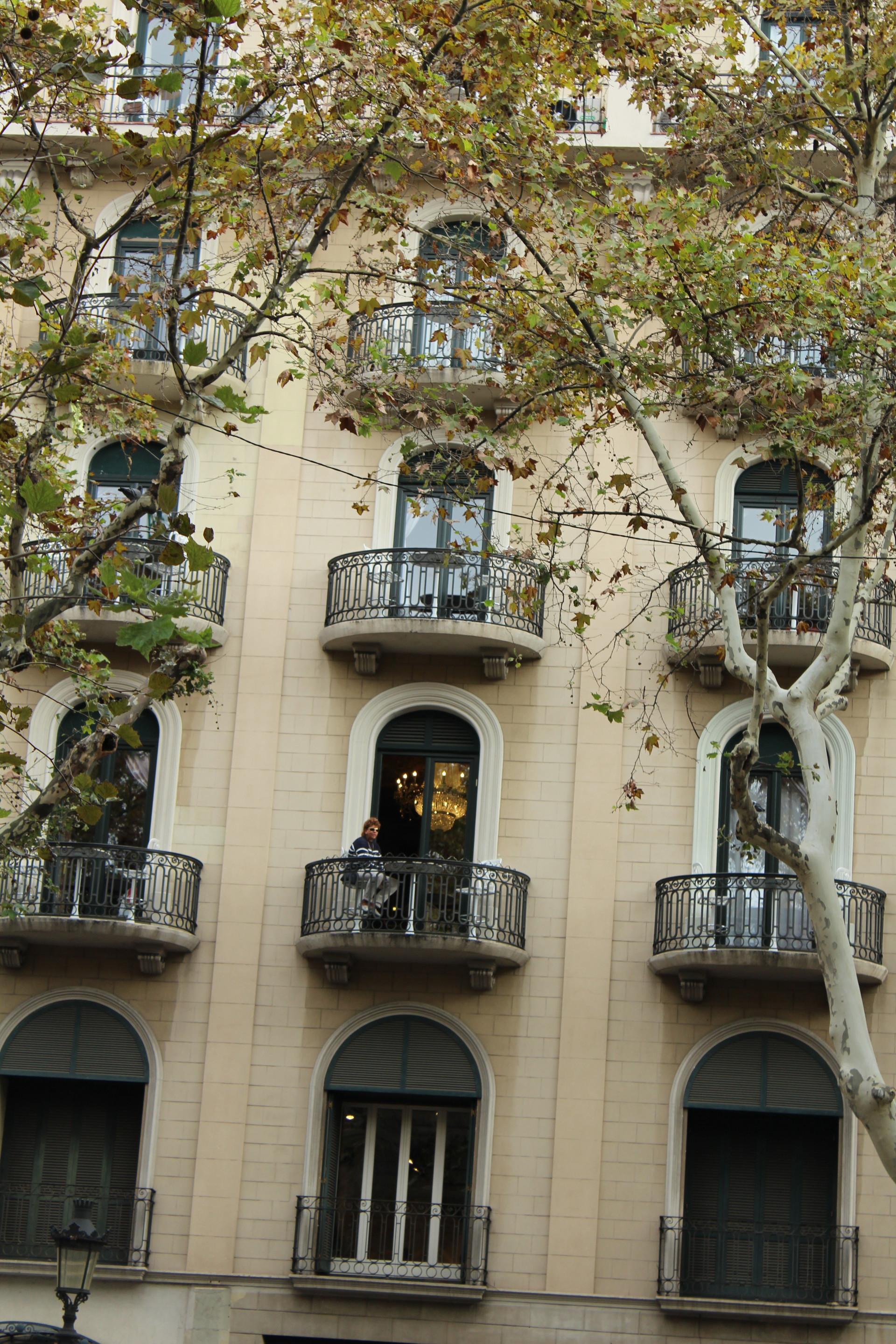
It's a nice walk and the region is great! Very central and really close to the most famous attractions in town is a nice place to stay while you're there as a tourist.
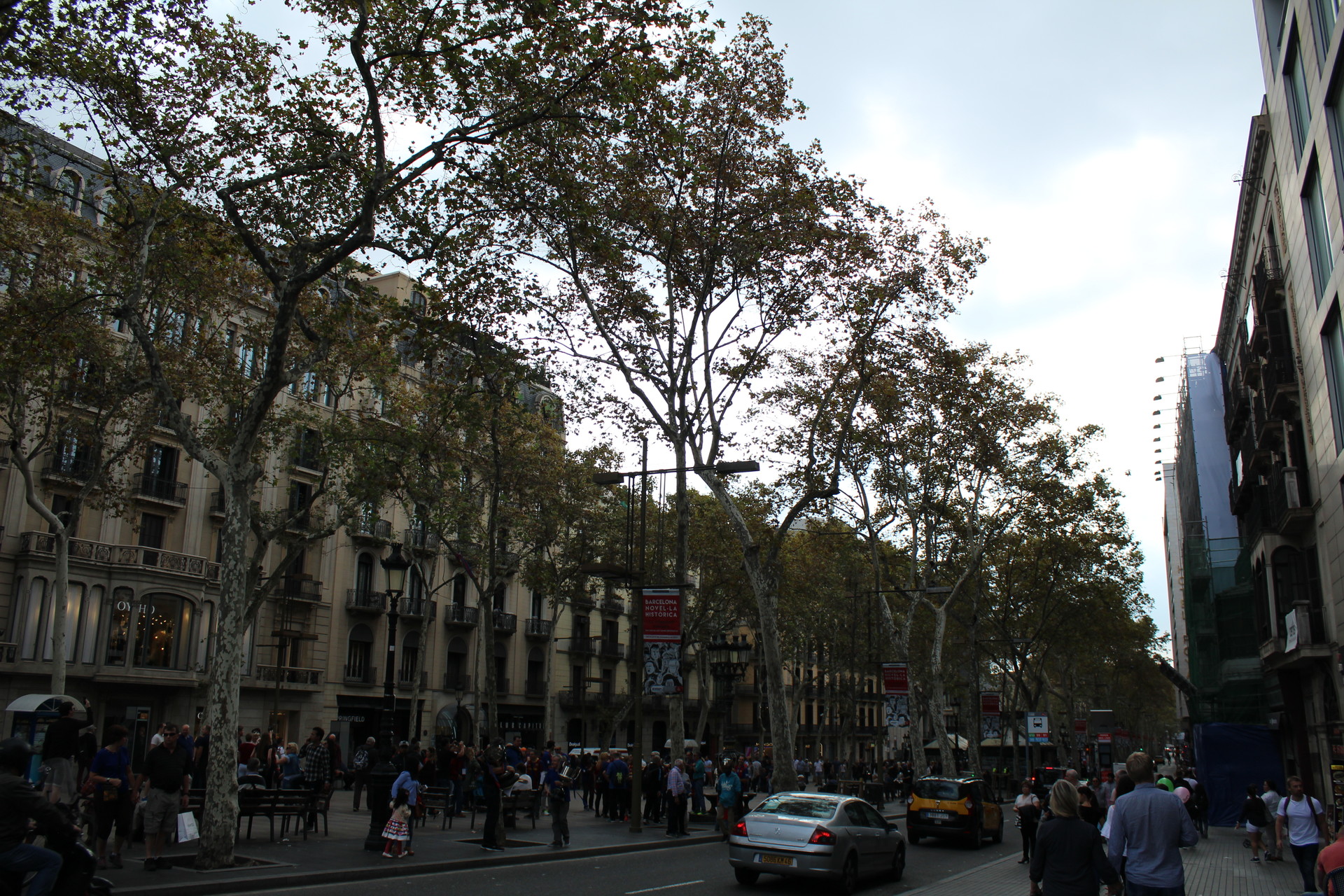
Photo gallery
Content available in other languages
- Español: El mejor paseo
Rate and comment about this place!
Do you know Las Ramblas? Share your opinion about this place.










